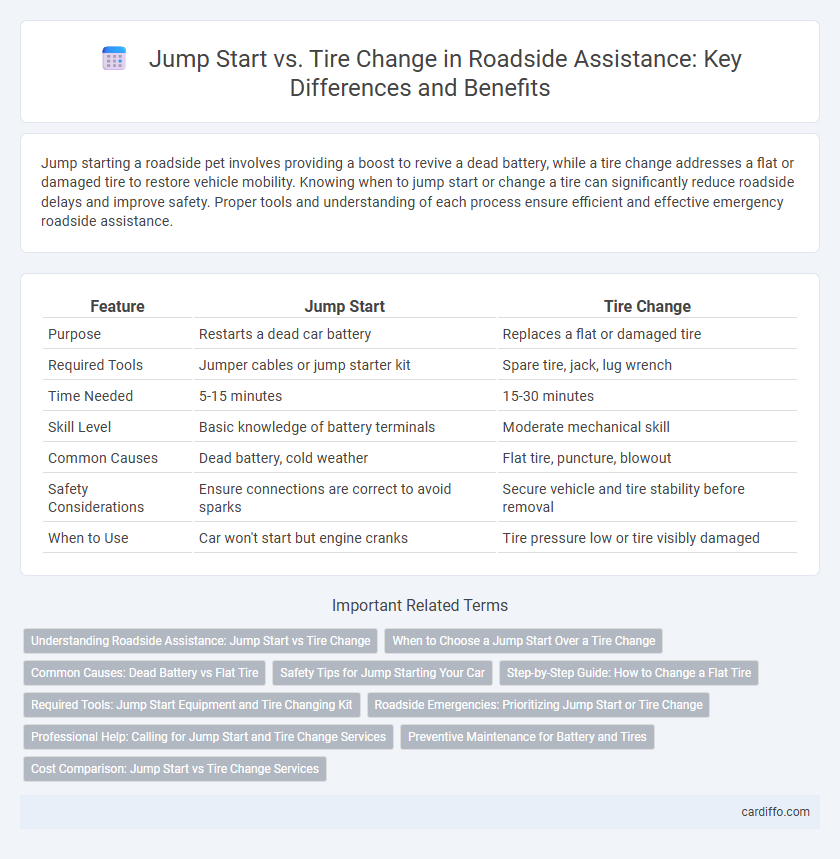Jump starting a roadside pet involves providing a boost to revive a dead battery, while a tire change addresses a flat or damaged tire to restore vehicle mobility. Knowing when to jump start or change a tire can significantly reduce roadside delays and improve safety. Proper tools and understanding of each process ensure efficient and effective emergency roadside assistance.
Table of Comparison
| Feature | Jump Start | Tire Change |
|---|---|---|
| Purpose | Restarts a dead car battery | Replaces a flat or damaged tire |
| Required Tools | Jumper cables or jump starter kit | Spare tire, jack, lug wrench |
| Time Needed | 5-15 minutes | 15-30 minutes |
| Skill Level | Basic knowledge of battery terminals | Moderate mechanical skill |
| Common Causes | Dead battery, cold weather | Flat tire, puncture, blowout |
| Safety Considerations | Ensure connections are correct to avoid sparks | Secure vehicle and tire stability before removal |
| When to Use | Car won't start but engine cranks | Tire pressure low or tire visibly damaged |
Understanding Roadside Assistance: Jump Start vs Tire Change
Roadside assistance often includes critical services such as jump starts and tire changes, each addressing different emergency scenarios. A jump start is used to revive a dead battery, typically caused by leaving lights on or extreme temperatures, while a tire change is necessary when experiencing a flat or damaged tire that prevents safe driving. Understanding these services enables drivers to quickly identify their needs and request the appropriate help, ensuring minimal disruption and enhanced safety on the road.
When to Choose a Jump Start Over a Tire Change
Choose a jump start over a tire change when the vehicle's engine won't start due to a dead battery rather than a flat or damaged tire. Jump starting restores battery power quickly, enabling the car to start and avoid prolonged roadside delays. Tire changes are necessary only when the tire is punctured, flat, or visibly damaged, not when the issue is electrical or related to the battery.
Common Causes: Dead Battery vs Flat Tire
Dead batteries often result from extended periods of inactivity, extreme temperatures, or leaving lights on, making jump starts a frequent solution during roadside emergencies. Flat tires commonly occur due to punctures from sharp objects, worn-out tread, or sudden impacts, necessitating immediate tire changes to restore vehicle mobility. Understanding these prevalent causes helps drivers prepare and respond effectively to roadside breakdown situations.
Safety Tips for Jump Starting Your Car
When jump starting your car, always ensure both vehicles are turned off and parked securely to prevent accidental movement. Use insulated jumper cables and connect them in the correct order: positive terminals first, followed by negative terminals to a grounded metal surface away from the battery. Wear protective gloves and safety glasses to avoid acid burns or electrical shocks during the process.
Step-by-Step Guide: How to Change a Flat Tire
To change a flat tire safely, begin by parking your vehicle on a flat surface and engaging the parking brake to prevent movement. Next, use a lug wrench to slightly loosen the lug nuts before raising the car with a jack placed under the designated lift point. After removing the lug nuts and flat tire, mount the spare tire, tighten the lug nuts in a star pattern, lower the car, and give the nuts a final tightening to ensure proper security.
Required Tools: Jump Start Equipment and Tire Changing Kit
Jump start equipment requires a reliable portable battery booster or jumper cables connected to a power source, enabling a dead car battery to be recharged quickly. A tire changing kit must include a hydraulic jack, lug wrench, and a spare tire to effectively replace a flat or damaged tire on the roadside. Both toolsets are essential for roadside emergencies, but jump starts focus on electrical power restoration while tire kits are dedicated to mechanical replacement and safety.
Roadside Emergencies: Prioritizing Jump Start or Tire Change
In roadside emergencies, prioritizing a jump start or tire change depends on the immediate safety risk and vehicle operability. A dead battery requires a jump start to restore power and mobility, whereas a flat tire demands a prompt tire change to prevent further damage and ensure safe driving. Assessing the situation quickly helps determine which action is critical to resume safe travel efficiently.
Professional Help: Calling for Jump Start and Tire Change Services
Professional roadside assistance offers reliable jump start and tire change services, ensuring safe and efficient vehicle recovery. Certified technicians use specialized equipment to quickly diagnose battery issues and replace flat tires, reducing downtime and stress. Accessing expert help minimizes risks and guarantees proper repairs, enhancing overall road safety.
Preventive Maintenance for Battery and Tires
Regularly inspecting battery terminals for corrosion and ensuring tires maintain proper tread depth are vital preventive maintenance steps that enhance roadside safety. Jump starting a dead battery often signals underlying battery health issues, while frequent tire changes may indicate poor tire maintenance or alignment problems. Proactive battery testing and tire rotation can prevent unexpected roadside emergencies and extend vehicle component lifespan.
Cost Comparison: Jump Start vs Tire Change Services
Jump start services typically cost between $50 and $100, making them a more affordable option compared to tire change services, which range from $100 to $200 depending on the tire type and service provider. Labor charges and the urgency of service can affect pricing, with tire changes often requiring more time and specialized equipment. Choosing between a jump start and tire change depends on the specific roadside issue and the associated cost efficiency of the required service.
Jump start vs tire change Infographic

 cardiffo.com
cardiffo.com